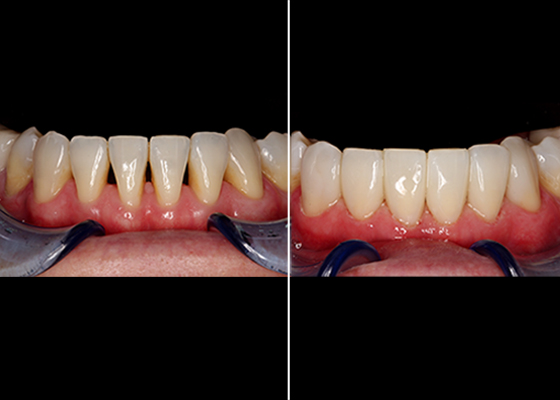Managing caries and motivating change, part 2: Motivational interviewing
How do you motivate your patients? Discover how caries risk assessments and motivational interviewing tactics can help you connect with…


Black triangles are a growing concern for patients, but not every clinician knows how to treat them. Learn how one versatile, predictable technique could help you close the gaps, improve patient acceptance and satisfaction and build your practice.
As the demand for esthetic dentistry has increased, so have patients’ awareness of their options – and the potential to preserve their natural teeth. This means more patients are seeking out minimally invasive esthetic treatments. While not every dentist is focused on cosmetics, one treatment in particular could help open doors for your practice – closing black triangles.
Black triangles, or open gingival embrasures, are a common dental issue – so common, in fact, that an estimated 67% of adults ages 20 and up suffer from this condition.1 Despite their frequency, it’s only recently that we’ve seen an increase in patient awareness and interest in treatment. And while there are a number of reasons these gaps can appear, from age to orthodontic treatment, these little triangles can have a big impact on quality of life. Increased food impaction can lead to tissue inflammation, and any dentin or cementum exposure can increase biofilm accumulation and the risk of caries. Not to mention the very real impact of esthetics on self-esteem.
Black triangle treatment represents a huge opportunity to improve confidence and oral health for your patients – and to grow your practice.
In the past, there were few treatment options available for black triangles, so dentists simply wouldn’t bring up the subject. As a result, many patients assumed nothing could be done. Even now, most of my new patients rarely mention their black triangles. If patients do bring them up, they often say that their previous dentists didn’t offer a treatment solution; which is understandable, because not every dentist is comfortable treating these difficult problem areas.
Bringing up black triangles yourself can be a great conversation starter. For patients who are unaware of the treatment, they’re usually pleasantly surprised to find that there is a minimally invasive solution to their distressing black triangles. Patients who are proactively seeking black triangle treatment are eager to discuss their options. Either way, I find treatment acceptance to be very high.
When you can offer a conservative treatment option, you can appeal to all your patients with black triangles, whether they’re actively seeking a solution or not.
Many dentists I’ve met tend to be nervous about treating black triangles because, as mentioned earlier, there haven’t been any simple, predictable solutions available thus far. And no dentist likes to cut lower teeth! Thin mandibular veneers have a high fracture and failure rate – and aren’t even guaranteed to close black triangles! Many of us have tried to fill the gaps with careful placement of direct composite, but this method doesn’t always end well, either functionally or cosmetically. Further, some methods can easily lead to gingival inflammation.
Enter the Bioclear® Method.
Also known as “injection molding,” the Bioclear Method is an additive treatment that requires little to no tooth structure removal. Warmed flowable and paste composite are injected into preformed anatomic mylar matrices, resulting in smooth contours in hard-to-access subgingival and interproximal areas – closing black triangles! Plus, it works for more than black triangles: the technique can also be used for diastemas, undersized laterals and other challenging cases, making it a versatile, functional and esthetic treatment option.
It’s not uncommon for dentists to try a new procedure or a new product and end up less than happy with their results, simply because they haven’t taken the time to learn and practice. However, as with adopting any new technique, training, practice and confidence are critical. It’s important to understand the principles behind the method before applying it clinically. To this end, take courses, virtually or live, that enable you to work on models. That practice can help you learn the procedure long before you treat your first patient.
Nevertheless, some dentists are still nervous about injection molding, even after training. I say: go for it! You’re not cutting or hurting the tooth – the worst that can happen is you take it off and start again. And practice makes perfect.

I’m always surprised at the number of dentists who don’t know how to treat black triangles. Most often, it’s simply a lack of familiarity. Dentists tend to stick with the techniques they know best, but this can lead to getting stuck in a rut and missing out on opportunities for growth.
One of the things that I talk about in my lectures is that we need to have fun at work. And if there is one thing that the Bioclear method has done for me, it’s made things fun. For me, satisfaction starts with predictability: in fact, closing black triangles with the Bioclear method is one of the most predictable procedures I do! There’s little chance of failure; I know it’s going to work, look natural, and blend in perfectly. And, the more black triangles you close, the more your confidence grows. Plus, it can be reversed! Unlike porcelain, it’s very easy to go back and correct the shade or polish the restoration if need be.
All of this combined means I can be confident in a positive outcomes and happy patients. I can tell my patients they’re going to love their results, and in my experience, they always do! And because of these consistent results, my staff shares my enthusiasm and confidence. Not everything in dentistry is predictable, so having a technique you can count on can be a real boost to your day. As a matter of fact, if I could close black triangles all day, I would!
As mentioned above, patients love their results every time. Not just the esthetic results, but the functional benefits as well – such as stabilized teeth in the mandibular and less food entrapment. I once had a patient say, “You need to tell your other patients how strong they make my teeth feel.” With this kind of feedback, why wouldn’t you want to close black triangles?
In the event patients need further convincing, which isn’t often, I carry a digital tablet in with me to show cases. Now, it’s gotten to the point where patients don’t even need to see cases because my enthusiasm and confidence say it all!
Over 90% of my patients don’t want their teeth cut, and they consistently remind me of that fact. I attribute this to patients’ increased awareness; they can look online anytime and see their alternatives. In fact, that’s how some patients find me. They’re looking for alternatives to invasive treatments and seek out dentists who have the same philosophy. Not just for black triangles, but for their entire smile.

It’s very important to work with your hygienist and the rest of your team to help patients see the benefits of treating their black triangles. My hygienist is one of our best educators and is very good at the acceptance conversation, to the point that I hardly have to say much of anything. By the time I walk in the room, the patient is ready discuss treatment.
Our practice emphasizes periodontal heath as well as its relationship to overall health. It’s easy to talk about when you have food impactions, bleeding gums, calculus buildup and plaque buildup. While my assistants tend to talk more about the cosmetic side of it, my hygienist can educate on both cosmetics and function – helping patients see the whole picture.
In my experience, discussing black triangles is a short conversation that goes one of two ways. If patients have black triangles, they either hate them and want them gone, or they don’t care. From there, I ask a series of questions about how the patient is affected. For example: Do people often tell you that you have food stuck in your teeth? Once you have an idea of how your patient feels about the triangles, it’s very easy to move forward with treatment.
Insurance is frequently a limiting factor for patients, as cosmetic treatments aren’t generally covered. Patients are usually eager to get rid of their black triangles once they know it is a possibility, but insurance coverage and affordability may hold them back. Respecting your patients’ financial situation is a part of treatment, which may mean postponing the black triangle discussion until the patient is in a better financial position.
The ideal treatment must have what I call the 3 P’s. It must be predictable, periodontally beneficial, and pretty. When you can check those three boxes every treatment is a home run. By adding the Bioclear Method to your repertoire, you’ll likely grow your esthetic practice. You’re also providing your patients with a predictable, minimally invasive treatment with both esthetic and functional benefits. What could be more rewarding than that?
Sources

How do you motivate your patients? Discover how caries risk assessments and motivational interviewing tactics can help you connect with…

Caries is a complicated multifactorial disease. In this two-part series, explore how caries risk assessments can help improve evaluation and…

Zirconia may be part of your everyday vocabulary, but how much do you know about this ceramic material? Learn more…